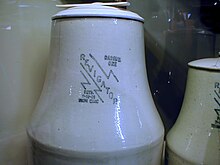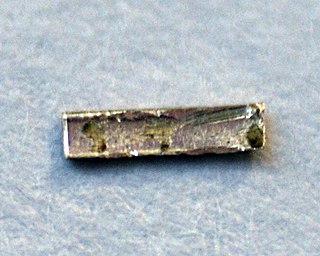
Radium is a chemical element; it has symbol Ra and atomic number 88. It is the sixth element in group 2 of the periodic table, also known as the alkaline earth metals. Pure radium is silvery-white, but it readily reacts with nitrogen (rather than oxygen) upon exposure to air, forming a black surface layer of radium nitride (Ra3N2). All isotopes of radium are radioactive, the most stable isotope being radium-226 with a half-life of 1,600 years. When radium decays, it emits ionizing radiation as a by-product, which can excite fluorescent chemicals and cause radioluminescence.

Radon is a chemical element; it has symbol Rn and atomic number 86. It is a radioactive noble gas and is colorless and odorless. Of the three naturally occurring radon isotopes, only radon-222 has a sufficiently long half-life for it to be released from the soil and rock, where it is generated. Radon isotopes are the immediate decay products of radium isotopes. Radon's most stable isotope, radon-222, has a half-life of only 3.8 days, making radon one of the rarest elements. Radon will be present on Earth for several billion more years, despite its half-life being a mere 3.8 days, because it is constantly being produced as a step in the decay chain of uranium-238, and that of thorium-232, each of which is an extremely abundant radioactive nuclide with a half-life of several billion years. The decay of radon produces many other short-lived nuclides, known as "radon daughters", ending at stable isotopes of lead. Radon-222 occurs in significant quantities as a step in the normal radioactive decay chain of uranium-238, also known as the uranium series, which slowly decays into a variety of radioactive nuclides and eventually decays into lead-206, which is stable. Radon-220 occurs in minute quantities as an intermediate step in the decay chain of thorium-232, also known as the thorium series, which eventually decays into lead-208, which is stable.
Radiation protection, also known as radiological protection, is defined by the International Atomic Energy Agency (IAEA) as "The protection of people from harmful effects of exposure to ionizing radiation, and the means for achieving this". Exposure can be from a source of radiation external to the human body or due to internal irradiation caused by the ingestion of radioactive contamination.
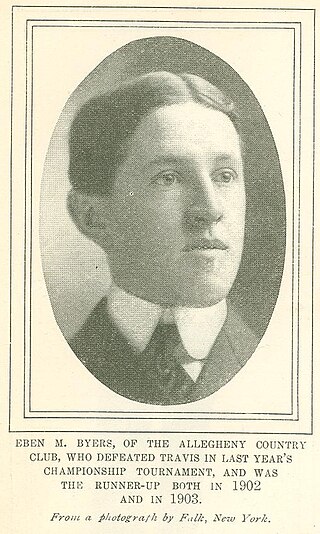
Ebenezer McBurney Byers was an American socialite, sportsman, and industrialist. He won the 1906 U.S. Amateur in golf. He died from multiple radiation-induced cancers after consuming Radithor, a patent medicine made from radium dissolved in water.

Tritium radioluminescence is the use of gaseous tritium, a radioactive isotope of hydrogen, to create visible light. Tritium emits electrons through beta decay and, when they interact with a phosphor material, light is emitted through the process of phosphorescence. The overall process of using a radioactive material to excite a phosphor and ultimately generate light is called radioluminescence. As tritium illumination requires no electrical energy, it has found wide use in applications such as emergency exit signs, illumination of wristwatches, and portable yet very reliable sources of low intensity light which won't degrade human night vision. Gun sights for night use and small lights used mostly by military personnel fall under the latter application.
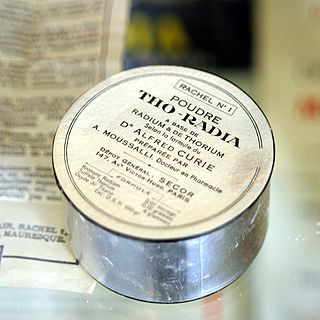
Radioactive quackery is quackery that improperly promotes radioactivity as a therapy for illnesses. Unlike radiotherapy, which is the scientifically sound use of radiation for the destruction of cells, quackery pseudo-scientifically promotes involving radioactive substances as a method of healing for cells and tissues. It was most popular during the early 20th century, after the discovery in 1896 of radioactive decay. The practice has widely declined, but is still actively practiced by some.
Eldorado Resources was a Canadian mining company active between 1926 and 1988. The company was originally established by brothers Charles and Gilbert LaBine as a gold mining enterprise in 1926, but transitioned to focus on radium in the 1930s and uranium beginning in the 1940s. The company was nationalized into a Crown corporation in 1943 when the Canadian federal government purchased share control. Eldorado Resources was merged with the Saskatchewan Mining Development Corporation in 1988 and the resulting entity was privatized as Cameco Corporation. The remediation of some mining sites and low-level nuclear waste continue to be overseen by the Government of Canada through Canada Eldor Inc., a subsidiary of the Canada Development Investment Corporation.

Radithor was a patent medicine that is a well-known example of radioactive quackery and specifically of excessively broad and pseudoscientific application of the principle of radiation hormesis. It consisted of triple-distilled water containing at a minimum 1 microcurie (37 kBq) each of the radium 226 and 228 isotopes.

Radium and radon are important contributors to environmental radioactivity. Radon occurs naturally as a result of decay of radioactive elements in soil and it can accumulate in houses built on areas where such decay occurs. Radon is a major cause of cancer; it is estimated to contribute to ~2% of all cancer related deaths in Europe.

Radium bromide is the bromide salt of radium, with the formula RaBr2. It is produced during the process of separating radium from uranium ore. This inorganic compound was discovered by Pierre and Marie Curie in 1898, and the discovery sparked a huge interest in radiochemistry and radiotherapy. Since elemental radium oxidizes readily in air and water, radium salts are the preferred chemical form of radium to work with. Even though it is more stable than elemental radium, radium bromide is still extremely toxic, and can explode under certain conditions.
Uranium tailings or uranium tails are a radioactive waste byproduct (tailings) of conventional uranium mining and uranium enrichment. They contain the radioactive decay products from the uranium decay chains, mainly the U-238 chain, and heavy metals. Long-term storage or disposal of tailings may pose a danger for public health and safety.

This is a list of criminal acts intentionally involving radioactive substances. Inclusion in this list does not necessarily imply that anyone involved was guilty of a crime. For accidents or crimes that involved radioactive substances unbeknownst to those involved, see the Nuclear and radiation accidents and incidents.
Naturally occurring radioactive materials (NORM) and technologically enhanced naturally occurring radioactive materials (TENORM) consist of materials, usually industrial wastes or by-products enriched with radioactive elements found in the environment, such as uranium, thorium and potassium and any of their decay products, such as radium and radon. Produced water discharges and spills are a good example of entering NORMs into the surrounding environment.

Uranium tiles have been used in the ceramics industry for many centuries, as uranium oxide makes an excellent ceramic glaze, and is reasonably abundant. In addition to its medical usage, radium was used in the 1920s and 1930s for making watch, clock and aircraft dials. Because it takes approximately three metric tons of uranium to extract 1 gram of radium, prodigious quantities of uranium were mined to sustain this new industry. The uranium ore itself was considered a waste product and taking advantage of this newly abundant resource, the tile and pottery industry had a relatively inexpensive and abundant source of glazing material. Vibrant colors of orange, yellow, red, green, blue, black, mauve, etc. were produced, and some 25% of all houses and apartments constructed during that period used bathroom or kitchen tiles that had been glazed with uranium. These can now be detected by a Geiger counter that detects the beta radiation emitted by uranium's decay chain.
William John Aloysius Bailey was an American patent medicine inventor and salesman. A Harvard University dropout, Bailey falsely claimed to be a doctor of medicine and promoted the use of radioactive radium as a cure for coughs, flu, and other common ailments. Although Bailey's Radium Laboratories in East Orange, New Jersey, was continually investigated by the Federal Trade Commission, he died wealthy from his many devices and products, including an aphrodisiac called Arium, marketed as a restorative that "renewed happiness and youthful thrill into the lives of married peoples whose attractions to each other had weakened."

The uranium mining debate covers the political and environmental controversies of uranium mining for use in either nuclear power or nuclear weapons.
Climax Uranium Mill is a decommissioned uranium mill near Grand Junction, CO.
The history of radiation therapy or radiotherapy can be traced back to experiments made soon after the discovery of X-rays (1895), when it was shown that exposure to radiation produced cutaneous burns. Influenced by electrotherapy and escharotics—the medical application of caustic substances—doctors began using radiation to treat growths and lesions produced by diseases such as lupus, basal cell carcinoma, and epithelioma. Radiation was generally believed to have bactericidal properties, so when radium was discovered, in addition to treatments similar to those used with x-rays, it was also used as an additive to medical treatments for diseases such as tuberculosis where there were resistant bacilli.

Nuclear labor issues exist within the international nuclear power industry and the nuclear weapons production sector worldwide, impacting upon the lives and health of laborers, itinerant workers and their families.
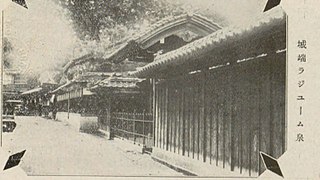
The radium fad or radium craze of the early 20th century was an early form of radioactive quackery that resulted in widespread marketing of radium-infused products as being beneficial to health. Many radium products contained no actual radium, in part because it was prohibitively expensive, which turned out to be a grace, as high levels of radium exposure can result in radiation-induced cancer.
